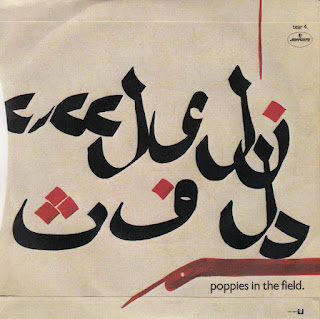Kilimanjaro
Recorded Summer 1980, released as b-side to "When I dream", September 1980
Julian Cope - bass(?), vocals
David Balfe - keyboards
Alan Gill - guitar
Gary Dwyer - drums
Written by Cope / Dwyer / Balfe / Gill
There is a long and notable history of album title songs not actually appearing on the album. Think of "Houses of the holy", "Bring it on", "Hex", "Waiting for the sun"... Julian Cope would add to the list himself when he issued "World shut you mouth" as a single two years after it had titled his debut solo album in 1984. He had the song in reserve apparently but didn't want to give such an obvious hit to his label. Or something. Maybe that's rewriting history a little.
But before that, the title track to "Kilimanjaro" the album had appeared on the b side of the single issued a month before the album. The song doesn't really have a place on the album, it's on its own and quite unique within the Teardrop Explodes catalogue.
It begins with a Burundi style drum pattern from Dwyer and immediately the listener knows this is something different for the Teardrops. The drums are swathed in reverb, in fact everything is in a reverb haze. Gill starts making unearthly squeaks and squeals from his guitar which is on the edge of feedback while Balfe is creating high tension drones on a synthesiser. After thirty seconds Balfe introduces a snaking synth melody, haunting and strange. At eighty seconds a multitude of overdubbed harmonising Copes starts singing one line of lyric - "We set sail a year and a day ago making our way to Kilimanjaro". Over and over, blank and plain. Why would you set sail there? There's no rivers around the mountain. Am I overthinking this? Meanwhile another layer of string synth is added (these days it would be called a pad) and Gill's guitar teeters on the edge of noise and dissonance. Dwyer's drums gets more random, Cope repeats the word "Kilimanjaro" over and over, and as the song careers towards some kind of ending Dwyer kicks off another tribal drum pattern and the song fades out.
"Kilimanjaro" then is a mood piece, almost a tone poem. There's no way a song as strange and beautiful as this would fit onto the album of the same name. It is a perfect b side, though - a glimpse of another route for the band. Note that it is credited to all four members of the group, so it may well have developed from a jam session. "Kilimanjaro" was used as the band's intro music during their early 1981 dates and in "Head On" Cope describes the song as if it "sounded as though it was recorded in a volcano on some Pacific atoll". He nails it there - the spooked vibe of the song is unique up to this point in the band's catalogue.
It may be without antecedents in the Teardrops catalogue but you could make a case for there being some kind of sublimated influence from another song. There's definitely a similar vibe on the title track of "Taking Tiger Mountain by strategy" by Brian Eno. Sure there's no tribal drums but there is a slow build of atmosphere and a repeated harmonised vocal, and a similar weariness in that one stanza of lyric - "We climbed and we climbed, oh how we climbed...over the stars to top Tiger Mountain, forcing the lines through the snow". While Cope has never indicated any knowledge of Eno's work, I'm sure Alan Gill would have been aware of the second Eno album. So maybe an influence? You decide.
On the other hand... Maybe other people were listening. Are there other examples of Burundi style tribal drumming from the time? If we ignore Adam and the Ants who are just around the corner, and notice that Budgie of the Slits taught Gary Dwyer to drum, we arrive at "All my colours" aka "Zimbo" by Echo and the Bunnymen. Now as far as I can tell, the first performance of "Zimbo" was on 18th November 1980 (ignore the June 1980 Netherlands date on setlist.fm, it's from 1981 really) which is a good two months after "When I dream" was released. So was "Zimbo" influenced by "Kilimanjaro"? Who knows? Perhaps someone braver than me should ask Will Sergeant on Twitter, see what he says. But it's odd that two months after the Teardrops issue a tribal drumming song, the Bunnymen start playing a song with their own interpretation of the Burundi beat. Coincidence? Hmm.
Cope always stated he wanted Teardrop Explodes b sides to be something cool, something different, an alternative viewpoint on the band. As such "Kilimanjaro" achieves all of these goals. The band were very rarely allowed to jam, and it is the only time all four members of the band would be allocated songwriting royalties. It's also an example of the potential of this lineup of the band - any previous lineup would never have created something like this. Any casual fan who bought "When I dream" would be surprised and intrigued to hear the b side, and it certainly sets the standard for future b-sides by the band. Their next b-side would be even odder than this one.



Two things occur to me as I listen to this track, whilst reading your excellent description: Joni Mitchell's 'The Jungle Line', from 1975's "Hissing of Summer Lawns" was the track that introduced me to the jungle drummers of Burundi, and the final drum bit - it starts at about 4:15 of the track - is a direct lift from the outro of Harry Nilsson's 'Jump Into The Fire' from 1971's "Nilsson Schmilsson".
ReplyDeleteBoth are probably a stretch, but the latter was a massive radio hit in the States, and it's likely that it made it over here to the UK. Loving the blog!